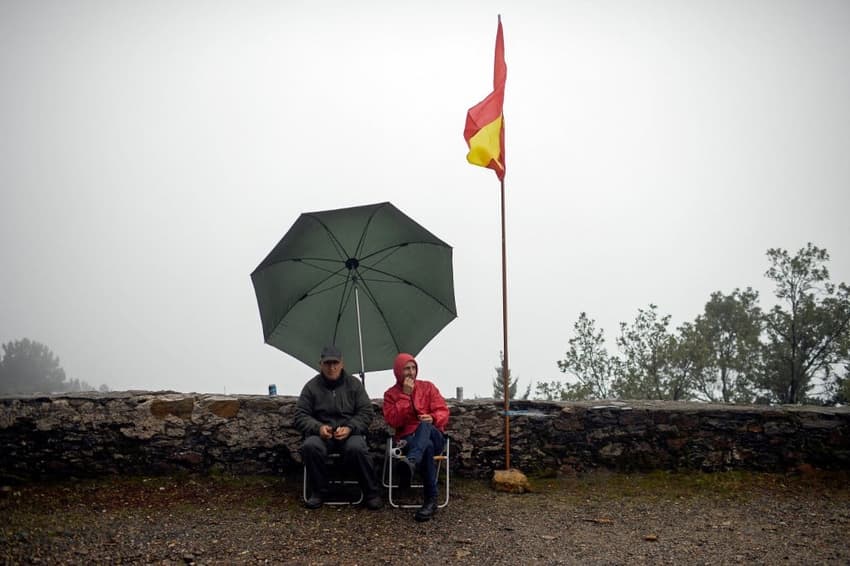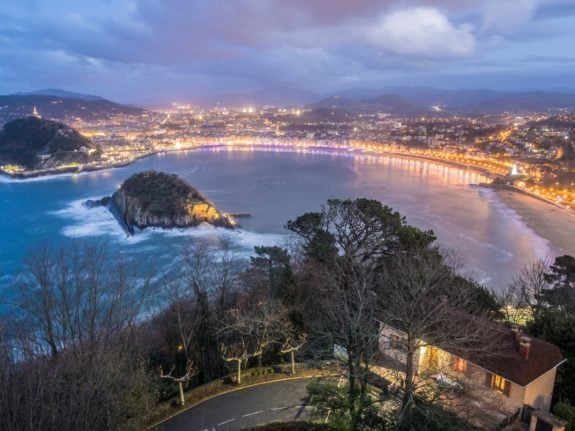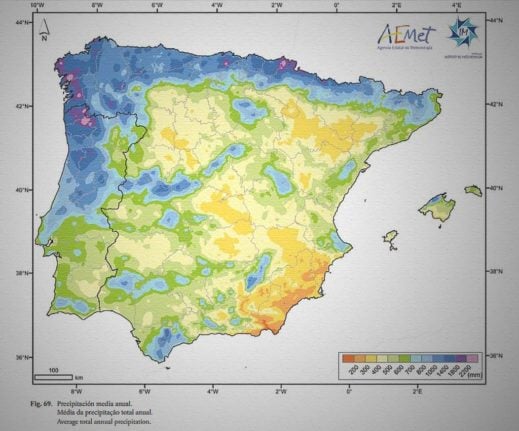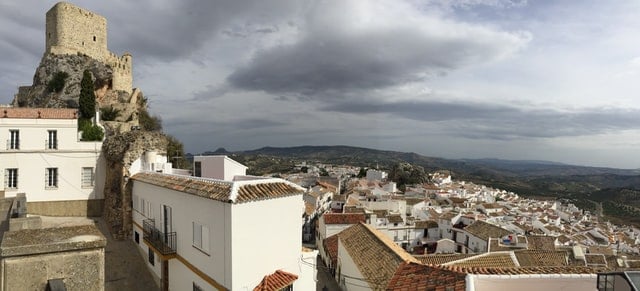Where are the rainiest places in Spain?

Is it true that the rain in Spain stays mainly on the plain? Here’s a breakdown of the cities and other locations where it rains the most in Spain.
Spain isn’t a country that’s associated with cloudy and rainy weather but anyone who’s travelled around the Iberian nation will know that sunny skies aren’t always guaranteed.
There are in fact parts of the country where there’s rain for half of the year.
And no, the line 'the rain in Spain stays mainly in the plain' - conceived as a way to judge proper English pronunciation during Victorian times - isn’t scientifically accurate.
Weather patterns are changing as the world’s climatologists have made many of us aware of, but if there is a place that’s historically rainy it’s northern Spain.
A climate guide by Spain’s national weather agency Aemet which looked at weather stats from 1981 to 2010 found that the rainiest city in Spain is the Basque city of San Sebastián, where there is rain on average 141.1 days every year.

It rains a lot in the classy Basque city of San Sebastián, also known as Donostia. Photo: Raul Cacho Oses/Unsplash
The following six rainiest cities after San Sebastián are all in the coastal windswept region of Galicia in northwestern Spain.
As you will see in the breakdown below, there is a clear north-south divide in terms of average precipitation in Spain, with the first 27 spots occupied by cities that are north of Madrid.
The rainiest cities in Spain:
1 San Sebastián - 141.1 days of rain a year
2 Santiago de Compostela - 139.5 days of rain a year
3 Pontevedra - 131.3 days of rain a year
4 A Coruña - 129.6 days of rain a year
5 Vigo - 129.2 days of rain a year
6 Lugo - 126.3 days of rain a year
7 Bilbao - 124.0 days of rain a year
8 Santander - 123.6 days of rain a year
9 Oviedo - 122.3 days of rain a year
10 Vitoria-Gasteiz - 99.3 days of rain a year
11 Ourense - 96.9 days of rain a year
12 Pamplona - 93.5 days of rain a year
13 Burgos - 83.5 days of rain a year
14 Soria - 78.8 days of rain a year
15 Segovia - 78.6 days of rain a year
16 León - 74.9 days of rain a year
17 Guadalajara - 74.1 days of rain a year
18 Cuenca - 71.2 days of rain a year
19 Valladolid - 68.5 days of rain a year
20 Ávila - 66.9 days of rain a year
21 Logroño - 66.6 days of rain a year
22 Girona - 65.8 days of rain a year
23 Cáceres - 64.2 days of rain a year
24 Zamora - 64.2 days of rain a year
25 Salamanca - 63.8 days of rain a year
26 Maó (Menorca) - 63.6 days of rain a year
27 Huesca - 60.7 days of rain a year
28 Madrid - 59.4 days of rain a year
29 Ciudad Real - 59.3 days of rain a year
30 Badajoz - 59.2 days of rain a year
31 Teruel - 57.4 days of rain a year
32 Córdoba - 56.6 days of rain a year
33 Toledo - 53.8 days of rain a year
34 Barcelona - 53.3 days of rain a year
35 Palma (Mallorca) - 53.1 days of rain a year
36 Granada - 52.1 days of rain a year
37 Huelva - 51.5 days of rain a year
38 Zaragoza - 51.1 days of rain a year
39 Cádiz - 50.7 days of rain a year
40 Sevilla - 50.5 days of rain a year
41 Albacete - 50.4 days of rain a year
42 Tarragona - 50.3 days of rain a year
43 Lleida - 46.2 days of rain a year
44 Jaén - 46.0 days of rain a year
45 Castellón - 45.5 days of rain a year
46 Valencia - 43.9 days of rain a year
47 Málaga - 42.3 days of rain a year
48 Alicante - 37.5 days of rain a year
49 Murcia - 36.5 days of rain a year
50 Santa Cruz de Tenerife - 29.7 days of rain a year
51 Almería - 25.4 days of rain a year
This map of Spain by Aemet, which doesn’t include the Canary Islands, shows where the average rainfall in millilitres is highest, again reflecting the stark difference between the country’s northern coastline (mostly in blue due to higher precipitation) and the rest of the country.

Map showing average annual rainfall in the Iberian Peninsula and the Balearic Islands. Source: Aemet weather agency
But if you look closer, you’ll see that in Spain’s southern tip there’s also an area with a high amount of rainfall.
This is Cádiz province, more specifically the Sierra de Grazalema, a mountainous range that records around 4,000 mm of rainfall per square metre a year.
Even though it doesn’t rain that often in Cádiz city, the nearby Sierra de Grazalema is widely regarded as the rainiest place in Spain, making Cádiz the rainiest province in Spain, ahead of other cloud-covered Galician provinces such as Pontevedra and Vigo.

Dark clouds approaching the village of Zahara de la Sierra in the Grazalema region. Photo: José Luis Rodríguez Martínez/Unsplash
Other mountain ranges (and their closeby villages and towns) such as the Sierra de Gredos in central Spain and the Navarran Pyrenees and Cantabrian Mountains in the north record high levels of rainfall throughout much of the year.
But if there is a region where rain is common throughout its cities, countryside and most of its territory it has to be Galicia.
A lot of the time it’s drizzle, but in specific areas of the Rías Baixas or the Barbanza region rainfall amounts to 2,500 litres per square metre per year .
Its climate is oceanic, temperate, humid and very variable throughout the year, and most of the storms that are generated in the Atlantic enter the Iberian Peninsula through Galicia, all of which contributes to the often 150 days of rain a year in the region.
It’s no surprise Gallegos (Galician people) have more than 100 words to describe rain.
READ ALSO: Where are the coldest places in Spain?
Comments
See Also
Spain isn’t a country that’s associated with cloudy and rainy weather but anyone who’s travelled around the Iberian nation will know that sunny skies aren’t always guaranteed.
There are in fact parts of the country where there’s rain for half of the year.
And no, the line 'the rain in Spain stays mainly in the plain' - conceived as a way to judge proper English pronunciation during Victorian times - isn’t scientifically accurate.
Weather patterns are changing as the world’s climatologists have made many of us aware of, but if there is a place that’s historically rainy it’s northern Spain.
A climate guide by Spain’s national weather agency Aemet which looked at weather stats from 1981 to 2010 found that the rainiest city in Spain is the Basque city of San Sebastián, where there is rain on average 141.1 days every year.

The following six rainiest cities after San Sebastián are all in the coastal windswept region of Galicia in northwestern Spain.
As you will see in the breakdown below, there is a clear north-south divide in terms of average precipitation in Spain, with the first 27 spots occupied by cities that are north of Madrid.
The rainiest cities in Spain:
1 San Sebastián - 141.1 days of rain a year
2 Santiago de Compostela - 139.5 days of rain a year
3 Pontevedra - 131.3 days of rain a year
4 A Coruña - 129.6 days of rain a year
5 Vigo - 129.2 days of rain a year
6 Lugo - 126.3 days of rain a year
7 Bilbao - 124.0 days of rain a year
8 Santander - 123.6 days of rain a year
9 Oviedo - 122.3 days of rain a year
10 Vitoria-Gasteiz - 99.3 days of rain a year
11 Ourense - 96.9 days of rain a year
12 Pamplona - 93.5 days of rain a year
13 Burgos - 83.5 days of rain a year
14 Soria - 78.8 days of rain a year
15 Segovia - 78.6 days of rain a year
16 León - 74.9 days of rain a year
17 Guadalajara - 74.1 days of rain a year
18 Cuenca - 71.2 days of rain a year
19 Valladolid - 68.5 days of rain a year
20 Ávila - 66.9 days of rain a year
21 Logroño - 66.6 days of rain a year
22 Girona - 65.8 days of rain a year
23 Cáceres - 64.2 days of rain a year
24 Zamora - 64.2 days of rain a year
25 Salamanca - 63.8 days of rain a year
26 Maó (Menorca) - 63.6 days of rain a year
27 Huesca - 60.7 days of rain a year
28 Madrid - 59.4 days of rain a year
29 Ciudad Real - 59.3 days of rain a year
30 Badajoz - 59.2 days of rain a year
31 Teruel - 57.4 days of rain a year
32 Córdoba - 56.6 days of rain a year
33 Toledo - 53.8 days of rain a year
34 Barcelona - 53.3 days of rain a year
35 Palma (Mallorca) - 53.1 days of rain a year
36 Granada - 52.1 days of rain a year
37 Huelva - 51.5 days of rain a year
38 Zaragoza - 51.1 days of rain a year
39 Cádiz - 50.7 days of rain a year
40 Sevilla - 50.5 days of rain a year
41 Albacete - 50.4 days of rain a year
42 Tarragona - 50.3 days of rain a year
43 Lleida - 46.2 days of rain a year
44 Jaén - 46.0 days of rain a year
45 Castellón - 45.5 days of rain a year
46 Valencia - 43.9 days of rain a year
47 Málaga - 42.3 days of rain a year
48 Alicante - 37.5 days of rain a year
49 Murcia - 36.5 days of rain a year
50 Santa Cruz de Tenerife - 29.7 days of rain a year
51 Almería - 25.4 days of rain a year
This map of Spain by Aemet, which doesn’t include the Canary Islands, shows where the average rainfall in millilitres is highest, again reflecting the stark difference between the country’s northern coastline (mostly in blue due to higher precipitation) and the rest of the country.

But if you look closer, you’ll see that in Spain’s southern tip there’s also an area with a high amount of rainfall.
This is Cádiz province, more specifically the Sierra de Grazalema, a mountainous range that records around 4,000 mm of rainfall per square metre a year.
Even though it doesn’t rain that often in Cádiz city, the nearby Sierra de Grazalema is widely regarded as the rainiest place in Spain, making Cádiz the rainiest province in Spain, ahead of other cloud-covered Galician provinces such as Pontevedra and Vigo.

Other mountain ranges (and their closeby villages and towns) such as the Sierra de Gredos in central Spain and the Navarran Pyrenees and Cantabrian Mountains in the north record high levels of rainfall throughout much of the year.
But if there is a region where rain is common throughout its cities, countryside and most of its territory it has to be Galicia.
A lot of the time it’s drizzle, but in specific areas of the Rías Baixas or the Barbanza region rainfall amounts to 2,500 litres per square metre per year .
Its climate is oceanic, temperate, humid and very variable throughout the year, and most of the storms that are generated in the Atlantic enter the Iberian Peninsula through Galicia, all of which contributes to the often 150 days of rain a year in the region.
It’s no surprise Gallegos (Galician people) have more than 100 words to describe rain.
READ ALSO: Where are the coldest places in Spain?
Join the conversation in our comments section below. Share your own views and experience and if you have a question or suggestion for our journalists then email us at [email protected].
Please keep comments civil, constructive and on topic – and make sure to read our terms of use before getting involved.
Please log in here to leave a comment.